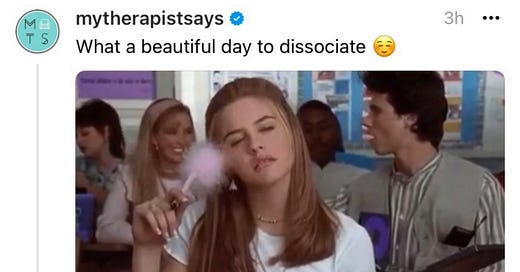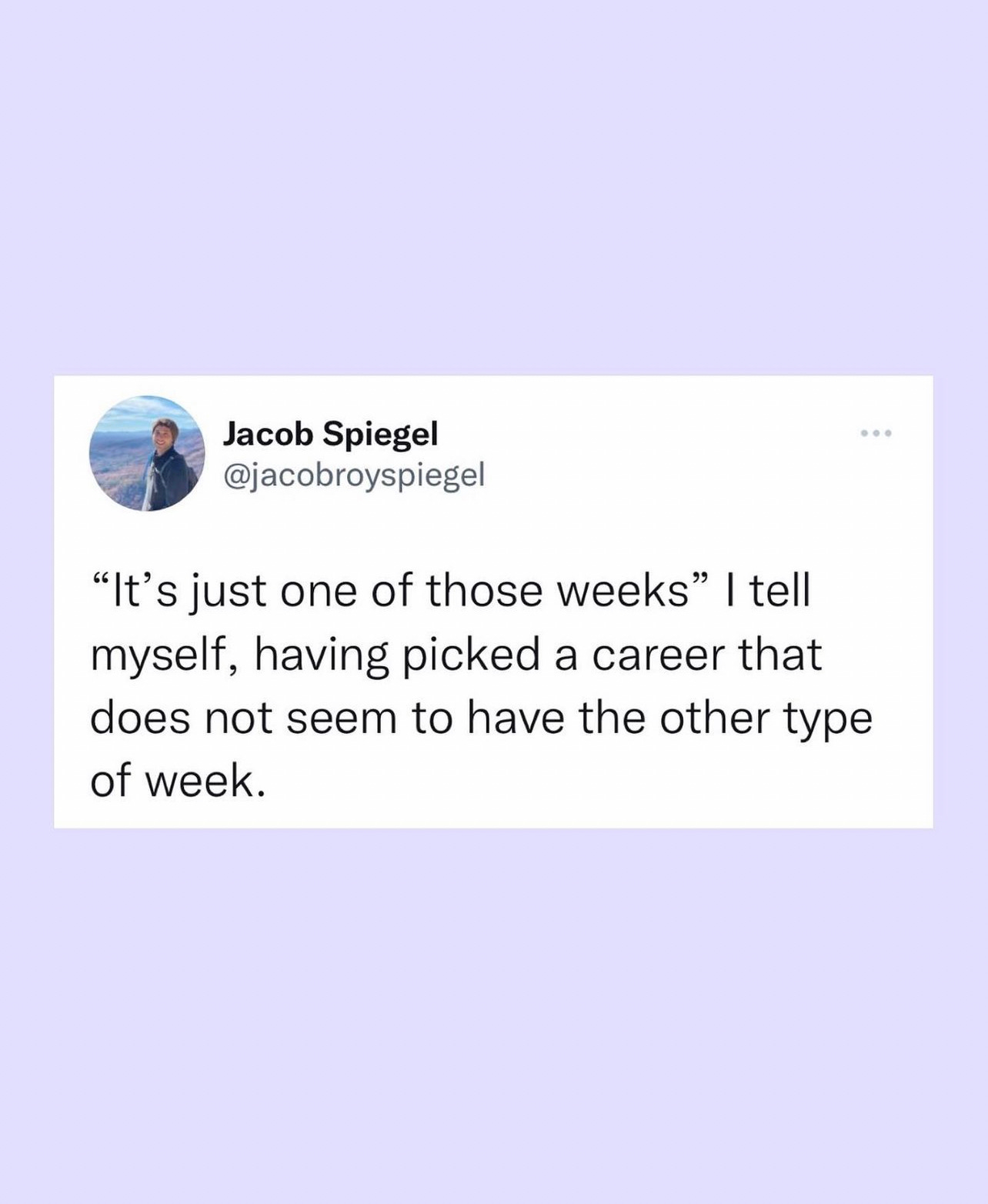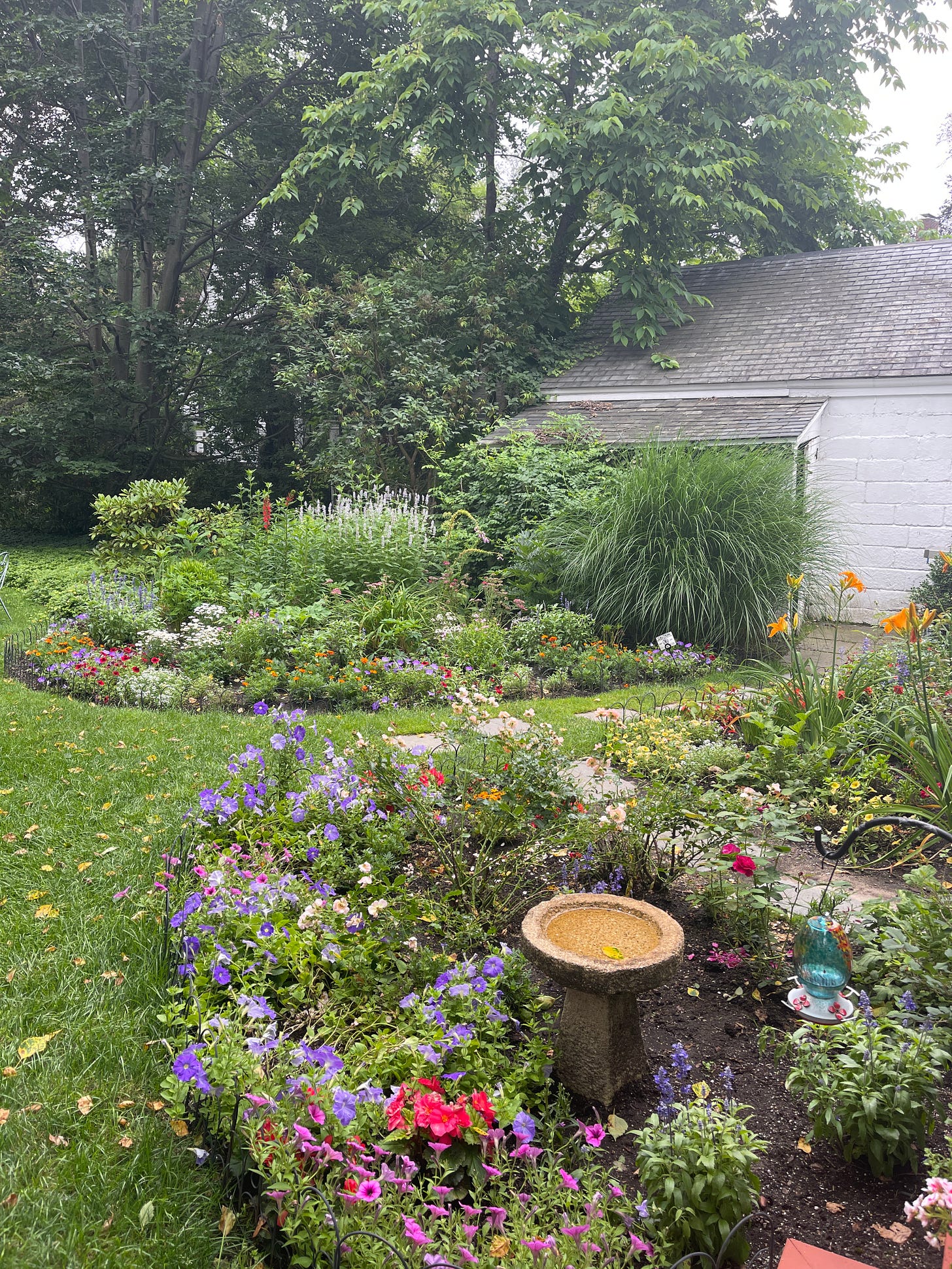This is an important topic that I’ve been hesitant to write about for a few different reasons.
One being the concept of disassociation has been somewhat glamorized and romanticized on social media. Certainly the internet is useful to bring awareness to a lot of different topics, though I don’t at all want to turn something serious into something glib like the meme below.
The sensation of dissociation is a mental process of disconnecting from one’s thoughts, feelings, memories or sense of identity. Whereas dissociative disorders such as dissociative amnesia, depersonalization disorder and dissociative identity disorder are more chronic states. The former is a temporary feeling, whereas the latter is a more pervasive and disruptive framework through which you view and experience the world.
Throughout this initial 10-part series, I’ve broken down the different layers of burnout I’ve experienced and how they’ve negatively impacted my non-work life, ranging all over the emotion spectrum, including: anger, overstimulation, overwhelm, distraction, inattention, perfectionism, negative self-talk, self-criticism (sometimes self-loathing) and imposter phenomenon.
When all of the above feelings combine on a single day, particularly on a work day that is not yet over, with so much responsibility, and so little control, all of my cognitive processing shuts down. And I tumble into a place of pseudo un-feeling just to make it through the rest of the day. As a coping mechanism in the moment, I have to almost remove myself from my body because I’m so overwhelmed and uncomfortable.
This is absolutely not talked about in medical curriculum schooling, and yet is absolutely so common. Especially after COVID, I feel confident we’ll start to see more studies looking at this link between the volume of tasks and emotional regulation in healthcare and that of dissociation.
Per one article in The Slate, “complex PTSD is characterized in adults by dissociation, difficulty in relationships, destructive behaviors (e.g., substance use), difficulty controlling emotions, and feelings of shame and guilt. For health care workers, it is no leap of the imagination to view the uncertainty, exhaustion, stress, grief, and lack of support as forms of complex trauma. Nor is it a leap to view the resulting dissonance, instability, avoidant coping, disorientation, and dissociation as responses to this complex trauma.”
This is the really terrifying side of burnout - the tumble into numbness. Being in this place of avoidance and dissociation for extended periods of time makes it so that I’m operating in a much more narrow frame of emotion - not letting myself feel too sad as a protective mechanism. Though unfortunately, for every action there is an equal and opposite reaction, meaning I’m also not able to feel all of the wonderfully positive and joyful things in my life.
This place of numbness is far scarier than the big crying emotions. I would so much rather cry and feel big than feeling nothing at all. I’m not afraid of big emotions. I AM afraid of being emotionless.
The remedy is not just taking time off and taking a deep breath. It’s much more, and much deeper than that. Because it’s no guarantee that simply removing myself from the clinic for the day means I can tap back into my body. Often that feeling lingers and stretches its tentacles into my home and personal life.
At this point in this newsletter, I know some folks are probably thinking, ‘just leave your job!!’ And again - this feeling is not specific to my job. I am fortunate to know a lot of PAs and people in other positions in medicine, and can speak candidly with them about this experience. Most of the time, they note feeling similarly if working in a full-time clinical role. It’s not a fault of a particular individual, facility or specialty; it’s what’s happening in healthcare across the US. And when we continue to view it as a personalized experience, putting the blame on a single individual, we lose sight of the bigger picture - that this is happening EVERYWHERE.
Furthermore, there are so many amazing things about my job that are protective. I have such wonderful coworkers who serve as anchors, who know exactly how I’m feeling without me having to say it. To grow roots somewhere, to feel meaning and purpose in what you ado, and to feel support on your good and bad days is something so incredibly special.
If this newsletter has taught me anything, it’s not that the happiness and joy wasn’t always there, it’s just that I wasn’t really allowing myself to see and feel it. It was hidden underneath a veil of viscous fog that didn’t feel immediately accessible to me. I’ve been lost in the fog for a bit. Not just within the last few months of writing this newsletter, but probably for the last 5 years. Because of the very complicated maelstrom of emotions listed above and in the previous newsletters. And other life transitions (starting PA school, starting a relationship, ending PA school, ending a relationship, COVID, starting work in healthcare during a pandemic, blah blah blah!)
These transitions are not at all unique to me. And I say this not in a way to inspire pity, but in a way to inspire deep connection. We have ALL been going through it, if you work in healthcare or not.
What has been a great comfort of late is the book called ‘Life is in the Transitions’. In it, the author discusses the myth of a linear life. Most lives don’t follow the expected stereotypical trajectory. The school, job, house, kids, retirement, life in the suburbs bliss could not be farther than the *actual* norm. There are twists and turns and unexpected loops. Most people, in fact, spend about 60 years of their life in these transitions!! 60 years!!!! We are so disillusioned and sold on this linear life.
Being human is trudging through a lot of shit a lot of the time. And yet still finding meaning, joy, silliness, laughter and people to not only walk through the shit with, but to play in the mud.
And it was also so lovely to hear how people featured in the book emerged from their transitions and found meaning from them, rather than get swallowed up by them. Each and every story and narrative had an ending that extracted reflection, understanding and meaning from it (maybe the author cherry picked, though it definitely did not feel like it while reading it!)
Which leads me to my own recent transition - I dropped my hours as a family medicine PA. I’m now in person 2 days a week, virtual once a week, totaling 24 hours of seeing patients (equates to ~40 hours of work with all the admin, though I did of course take a pay cut).
And for these last few weeks since this change I wake up not knowing what day of the week it is. While this may seem like a trivial little change, this is HUGE for me. Previously, I was waking up and thinking “oh wow it’s only Tuesday, still 4 more days of this” and then “okay it’s Wednesday I’m almost half way through”.
I’m dipping my toe in other pools of possibility - starting an unpaid internship to enrich my nutrition learning and doing a bit of freelance work for a new health tech start-up. Things I still find interesting that appeal to learning and creativity.
When I was first thinking about dropping my hours, I’ll admit I felt a bit of shame in it. That by scaling back, patients wouldn’t have as much access to care. Though through some deep therapy work and talking with friends and family, I either do this now, or continue existing in a stale state, barely having enough energy to actually live my life.
Circling back to the topic at hand, I’ve been slowly crawling my way back from dissociation and burnout for the last year or so, inching closer to buoyancy and color after a few gray years.
And it’s been pretty heady - thinking, justifying, analyzing, and more thinking. Rather than getting trapped in analysis paralysis and trying to CBT my way out of things, this process has prioritized feeling over thinking. The shift back has been soft and gentle, which in a way has felt so hard. Because my brain naturally navigates towards over-thinking and intensity.
It has only become a bit easier in the last few weeks through lots of patience, presence, play, pleasure, and compassion. Here is what has been helpful:
things therapists have recommended to me:
stomp around from room to room in clinic when you can feel yourself start to slip to that place. focus on your feet as a reminder of where you physically are.
carry a crystal or other item in your pocket to clinic so you can focus on the physical object when things get overstimulating or overwhelming.
start every morning with masturbation (LOL someone really did recommend this to me as a way to actually be in my physical body and feel pleasure, especially on days when being present does not feel good)
things I have found helpful:
be mindful of the additional distractors and things that take you further away/out of your body (alcohol, too much caffeine, dehydration, skipping meals)
ask a loved one for a long hug or sway, especially if it’s swaying back and forth
take an ice pack and put it directly on your chest as a reminder of ‘ah yes I am here. hello.’
ease back into gentle sensory experiences: use floor and lamp lighting instead of overnight lighting, light candles, play soft and slow music, eat your favorite food without distraction, put on noise-canceling headphones and lay beneath a weighted blanket, see if there are float/sensory deprivation tanks in your area that you can try
get off your phone. and if you have to be on screens, set your screens to night mode, or your iPhone display to dark
be mindful of what you’re consuming and the people you’re following and the messages you’re subconsciously adopting via social media
start doing everything slower: walk slower, breathe slower, eat slower, read slower. envision savoring every small moment, even when you can’t always control how fast things are moving in other realms of life. it may lead to new opportunities (see photo of garden above. I was taking a slow Sunday stroll and saw a music stand in someone’s front yard inviting onlookers to view the garden in the backyard. We walked to the backyard and ended up meeting the conductor of the Boston Philharmonic Orchestra. We had the mostly lovely conversation about the power of community and connection.)
I cannot believe this was somehow my tenth newsletter. The spacing has been somewhat erratic because I wanted these first ten to stand as the pillars for the subsequent editions. Starting in August, to ensure I can continue pouring not only my time but my finances into it, some of the issues will be for paid subscribers only.
Paid subscribers will continue to get the weekly newsletter, which will include not only my musings, but life updates, new experiences, bringing others in for Q+As and features, and thoughts on specific topics that are personally contributing to some burnout in healthcare. This will total 3-4 newsletters per month.
Monthly unpaid subscribers will get my monthly recommendations / wrap-up thoughts about the month - one newsletter per month.
Thank you ALL for your support. It truly does mean the world to me.
HAPPILY!
Katie







